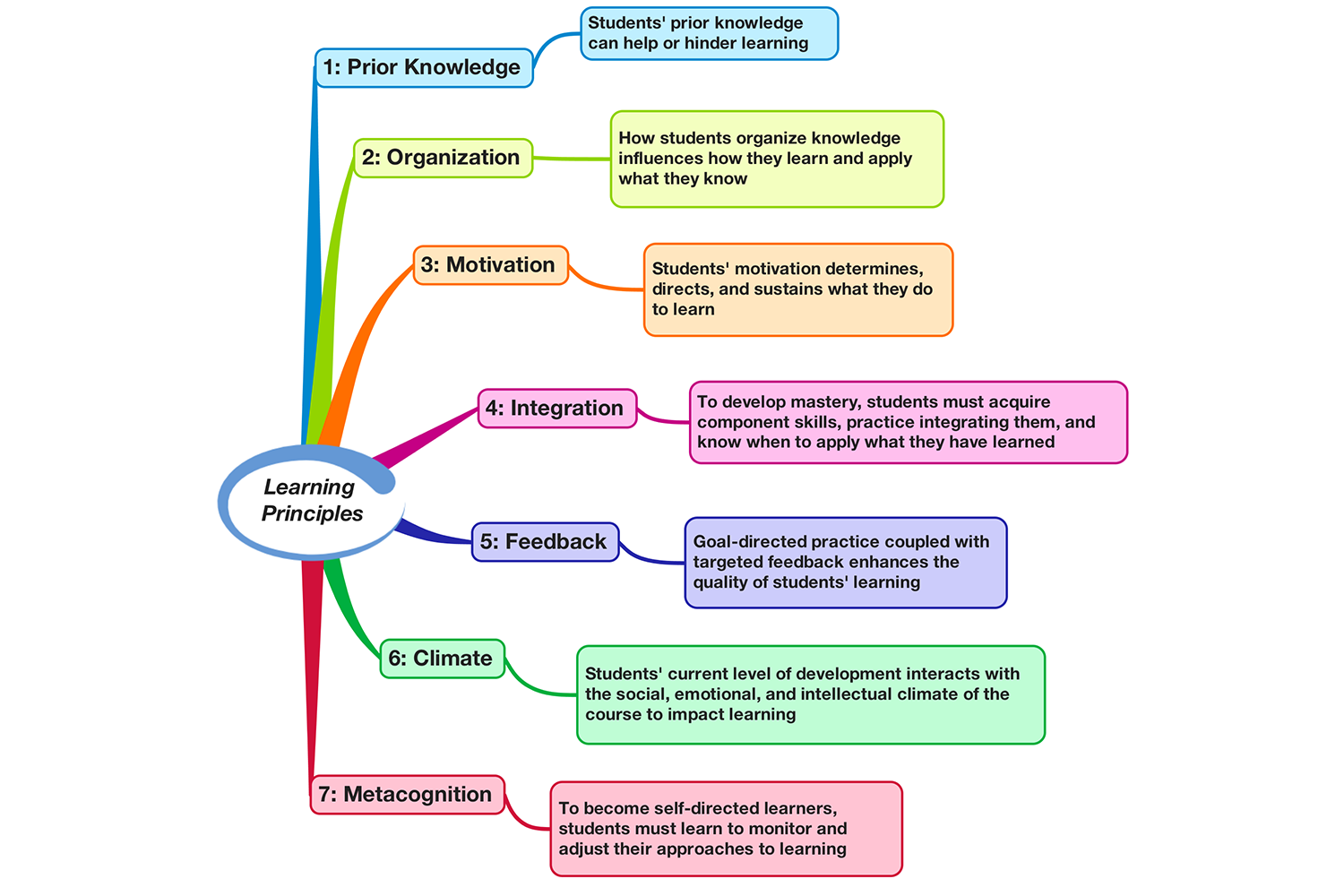Applying Learning Principles to Online Course Design

These learning principles were adapted from: Ambrose, S. A., Bridges, M. W., DiPietro, M., Lovett, M. C., & Norman, M. K. (2010). How learning works: Seven research-based principles for smart teaching. John Wiley & Sons.
There has been lots of exciting research coming out of the learning sciences lately, enabling us to design our courses to best adhere to how humans learn. Above are 7 of the most useful and distilled learning principles that we can use to better understand our learners, and how to teach our courses.
Let's see if we can apply these learning principles to online teaching!
Learning Principle #1: Students’ prior knowledge can help or hinder learning.
It's important to keep in mind that students do not come into these courses as blank slates, but rather with knowledge gained in other courses and through daily life.
This knowledge consists of an amalgam of facts, concepts, models, perceptions, beliefs, values, and attitudes. Some of the knowledge is accurate and complete, while some of their knowledge may be inaccurate and/or insufficient for the learning requirements of the course. As students bring this knowledge to bear in your classrooms, it influences how they filter and interpret incoming information.
The question is - how does one best get at the prior knowledge and misconceptions of students in a blended course such as yours?
Your course LMS (Learning Management System) is loaded with tools to get at the prior knowledge of your students - ask them:
- Surveys (Canvas | Blackboard | Moodle)
- Quizzes (Canvas | Blackboard | Moodle)
- Short Assignments (Canvas | Blackboard | Moodle)
- Discussion Prompts (Canvas | Blackboard | Moodle)
Learning Principle #2: How students organize knowledge influences how they learn and apply what they know.
We naturally make connections between the pieces of knowledge that we hold in our minds. When we can turn those connections into knowledge structures, and when those structures have meaning for us, we are much more capable of retrieving and using that information.
The question is - how does one best organize knowledge in an online course such as yours?
Suggestions:
- Use the Syllabus and/or Homepage Tools to its fullest (Canvas | Blackboard | Moodle
- Set up a well-organized course structure (Canvas | Blackboard | Moodle
- Use the Calendar Tool to its fullest (Canvas | BlackBoard | Moodle
Learning Principle #3: Students' motivation determines, directs, and sustains what they do to learn.
The importance of motivation (great webpage on from Vanderbilt U) in regards to learning cannot be overstated. In a blended course such as yours, students have the autonomy to decide when, how, and what to study and learn; motivation therefore plays a key role in helping to guide their behavior.
There are really just two concepts at the core of understanding motivation:
- The subjective value of the goal
- The expectations for the successful achievement of that goal
The question is - how does one best motivate students in an online course such as yours?
Learning Principle #4: To develop mastery, students must acquire component skills, practice integrating them, and know when to apply what they have learned.
Mastery refers to the attainment of a higher degree of competence within a particular area. For students to achieve mastery within a domain, they need to:
- develop a set of key component skills
- practice them to the point where they can be combined fluently and used with a fair degree of automaticity
- know when and where to apply them appropriately
Mastery happens in stages:
- Unconscious Incompetence - students have not yet developed skill in a particular domain, nor do they have sufficient knowledge to recognize what they need to learn
- Conscious Incompetence - students are increasingly aware of what they do not know and, consequently, of what they need to learn
- Conscious Competence - students have considerable competence in their domain, yet still must think and act deliberately and consciously
- Unconscious Competence - students reach the highest level of mastery, they move into a state in which they exercise the skills and knowledge in their domain so automatically and instinctively that they are no longer consciously aware of what they know or do
The question is - how does one best create a learning environment that can help lead students to mastering a particular domain?
Learning Principle #5: Goal - directed practice coupled with targeted feedback enhances the quality of students’ learning.
Goal-directed practice alone is insufficient to foster students’ learning. Goal-directed practice must be coordinated with targeted feedback in order to promote the greatest learning gains. The purpose of feedback is to help learners achieve a desired level of performance. Just as a map provides key information about a traveler’s current position to help him or her find an efficient route to a destination, effective feedback provides information about a learner’s current state of knowledge and performance that can guide him or her in working toward the learning goal. In other words, effective feedback can tell students what they are or are not understanding, where their performance is going well or poorly, and how they should direct their subsequent efforts.
The question is - what are the best ways to provide feedback in an online learning environment?
Suggestions:
- Canvas SpeedGrader is a great way to create audio/video comments quickly and easily.
- Record audio and video feedback easily in Blackboard.
- Create videos for feedback in Moodle.
Learning Principle #6: Students’ current level of development interacts with the social, emotional, and intellectual climate of the course to impact learning.
Learners are not only intellectual but also social and emotional beings, constantly developing those skills concurrently. While teachers can't necessarily control the developmental process, they can shape the intellectual, emotional, social, and physical aspects of the classroom climate in developmentally appropriate ways. A negative climate may impede learning and performance, but a positive climate can energize students' learning.
The question is - what are the best ways to create a climate, both f2f and virtually, most conducive to learning?
Learning Principle #7: To become self - directed learners, students must learn to monitor and adjust their approaches to learning.
Learners may engage in a variety of metacognitive processes to monitor and control their learning—assessing the task at hand, evaluating their own strengths and weaknesses, planning their approach, applying and monitoring various strategies, and reflecting on the degree to which their current approach is working. Unfortunately, students tend not to engage in these processes naturally. When students develop the skills to engage these processes, they gain intellectual habits that not only improve their performance but also their effectiveness as learners.
The research suggests that students tend not to apply metacognitive skills as often or well as they should. Students will often need support in learning, refining, and applying metacognitive skills.
Resources
Ambrose, S. A., Bridges, M. W., DiPietro, M., Lovett, M. C., & Norman, M. K. (2010). How learning works: Seven research-based principles for smart teaching John Wiley & Sons.
Canvas Instructor Guides - Website
Blackboard Instructor Guides - Website
Moodle Instructor Guides - Website
Dirksen, J. (2015). Design for how people learn New Riders.
Donovan, M. S., Bransford, J. D., & Pellegrino, J. W. (1999). How people learn Retrieved March, 8, 2006. Chicago
Georgia Tech's Center for Teaching and Learning - Website

Michael Cennamo is Associate Director of Educational Technology at the CVTI
